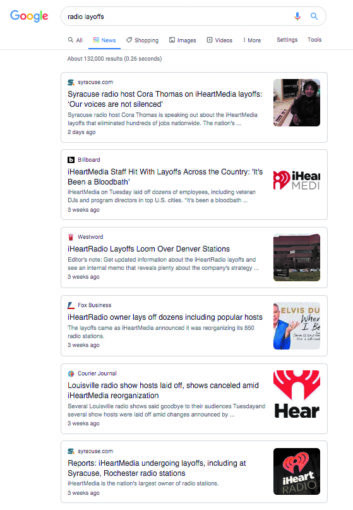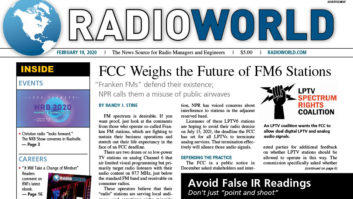
This article was originally posted on the JacoBlog from Jacobs Media Strategies.
Politics and radio are strange bedfellows, indeed.
We start with a senator from Ohio, Sherrod Brown and an odd mashup with radio. Aside from considering a run for president this year (he wisely decided against it), Brown made some headlines of his own in January.
It seems that in the middle of only the third impeachment hearing in the history of this 240 year-old republic, the senator from the Buckeye State felt it was important enough to write a letter to Bob Pittman.
Many of you no doubt saw his missive in the industry trades. Pointing directly to the mass layoffs in radio, Brown asked iHeartMedia’s CEO to explain the downsizing of so many stations — especially in his home state.
Among other concerns — including executive compensation and bonuses — Brown asked Pittman to respond to these questions by Feb. 14. I’ve abbreviated them below:
- How many workers were fired (and how many from Ohio)?
- What type of severance and health care benefits did they receive and for how long?
- Will these employees be given priority for open positioning in the future?
- Will these terminated employees receive training to help them qualify for new jobs?
Good questions all.
But the strange part is why a U.S. senator embroiled in one of the most controversial events in American history is even bothering to swoop in and ask questions about what is going on in broadcast radio.
Sherrod Brown is not the only one, nor is iHeartMedia the only company involved in layoffs these past few months. For an industry that has trouble agreeing on what belongs in the dashboard and how Nielsen should conduct the ratings, the radio industry has sadly come together on the issue of downsizing, terminations, layoffs, reductions in force, “dislocations” and whatever else you call them.
And the world is taking notice.
It’s an understatement, of course, but this is a challenging time for radio, perhaps the most trying since the medium became part of the American culture. Capitalism isn’t always pretty, and we’re watching its scary side at work here, as companies duke it out to survive in this roiling, highly charged environment.
Every industry — including tech — has been on the hot seat, balancing growth and sustainability, trying to figure out how to carve out a meaningful future, while maintaining quarter by quarter performance that sates investors and stakeholders.
In the commercial radio world, the pain is coursing through the hallways, conference rooms, cubicles and jock lounges. There are well more than 1,000 people and their families impacted by this latest round of cuts.
MAKING THE NEWS
There have been tough times in broadcast radio here in the U.S. before, but now it’s experiencing all sorts of blowback — just the type of bad PR it doesn’t need.
Especially now.
For an industry that rightfully prides itself on its good deeds during times of disaster — national and otherwise — as well as year-round fundraising and charitable pursuits, this negative coverage of broadcast radio at the beginning of a tenuous new year isn’t just unfortunate; it’s disturbing and troublesome.
If you search “radio layoffs” under Google News, you can now see the torrent of results that pop up — all 150,000+ of them.
This top group of search results all involve iHeart, but the more you scroll, the more stories you see — from Rolling Stone, the Washington Post and Robert Feder’s well-read blog, “Robservations,” to stories in smaller town publications like the Arkansas Business Journal, the Post and Courier (Charleston, S.C.) and the Daily Voice (White Plains, N.Y).
Then there was this blaring headline from Syracuse.com, an online news site published by the Post-Standard: “Does iHeartMedia have more radio stations than local DJs in Syracuse now?”
Ouch.
And the main message of these stories has been consistent, despite the widely varying markets and communities: Most lament the loss of air personalities, many of whom have commented or whose social media feeds have been clogged with outraged, aghast fans.
Interestingly, most of these DJs, shows and hosts haven’t expressed anger toward their former employers. In fact, many feel bad their voice is no longer being heard, often addressing the outpouring of emotion from fans.
Many also are partial commentaries on the state of the commercial radio business in the U.S. — or in their communities. Some wonder why some of the industry’s biggest companies are in the forefront of these layoffs. Others question the validity of claims like “live & local” in the face of these cutbacks.
Even the story of those six Des Moines DJs who got their jobs back after a pressure campaign from advertisers and listeners got coverage — by Rolling Stone no less — was no salve on the wounds. In fact, it only served to reinforce perceptions that big, bad companies are inexplicably and arbitrarily firing some of their most popular people.
RADIO’S PR BATTLE
P.T. Barnum, one of the greatest showmen of all time, once observed, “There’s no such thing as bad publicity.” But that’s a myth. These days, bad news travels faster than ever before, thanks to the power, efficiency and economy of the internet in general and social media specifically.
There’s no question radio — and all traditional media — have been under the gun financially. All the hyperbole in the world from the industry’s captains doesn’t mitigate the damage caused by the bad press that has accompanied this newest round of firings. Radio wasn’t exactly being treated as a media darling before this newest wave of axings went into effect, and newspapers have historically enjoyed dancing on radio’s grave — a key competitor for local revenue.
And while the companies in the forefront of these layoffs were all hoping to achieve economic savings, pay down debt and transition their efforts, you have to wonder if the collateral damage inflicted by these policies might not backfire on many fronts — sales, listenership and even the attractiveness of broadcast radio to younger generations.
We have often discussed the need for the radio industry to tell its story, but its story is now being told by media outlets with no qualms about throwing broadcasters under the bus. Radio can ill afford a wave of negative PR, questioning its efficacy as as local medium, as the coverage spins out of control.

Yes, these cuts are painful. But most radio companies have a strategic purpose behind these moves. Investment in digital personnel and services is part of the narrative. This may not make legacy workers feel any more comfortable, but it’s a reality of what the radio broadcasting industry is enduring. These new hires may not offset the losses, but they show that companies are not standing pat while they face competitive headwinds.
There’s a term in business — customer-facing. It refers to businesses that deal directly with consumers. And there are customer-facing employees — the barista who prepares your latte every morning, the receptionist at your dentist’s office who helps you set appointments, the knowledgeable geek at the electronics store who helps you make the best decisions.
And in the case of radio stations, the people on the air who cheerily wake us up every morning, who deliver the news and traffic information, who turn us on to new music and local concerts, who energize and anger us with their controversial views, who send us off to bed each night are the “listener-facing employees.”
When they disappear from the airwaves, the audience knows. They’re the people who are often the faces of their stations.
The role of on-air talent shouldn’t be underestimated, even for companies that have run their analyses, their reports and their forecasts about who’s expendable, who’s making too much money, who isn’t pulling their weight. While Wall Street may (temporarily) applaud these efforts, the audience doesn’t care about these factors nor should they be expected to.
Think about it — what’s the first thing people say to you once they find out you’re in the radio business? “Oh, are you on the air? Have I heard you on the radio?”
Paul Jacobs spends an amazing amount of time with local radio sales teams. And he reports that stations without a viable morning show often feel they have a distinct disadvantage, preventing them from garnering premium rates.
Far be it for me to offer advice to radio broadcasters about whether to slash and who should get pink-slipped. As you might expect, these cutbacks have impacted our business as well.
But the effects of radio’s staff reductions are more apparent when they’re focused on denizens of the air studio. Few actually notice if a sales manager, a production director, an office assistant or a consultant gets the ax. (And that’s not to say people in those job categories don’t contribute, because, of course, they do. But the noise is always louder when an on-air radio companion is given her walking papers.)
I’ve blogged about the often intangible value of air personalities here before — a lot. And that’s because in the big scheme of things, it’s the people on the radio that move the needle, that make us laugh, tick us off, and move us to visit a phone store or a car dealership. There’s more to planning cuts on a spreadsheet than simply looking at the hard numbers.
In fact, the ROI cliche might be better expressed on ROR — or return on reductions. How much money was truly saved this time around? And what is the collateral damage that’s been inflicted on radio as a result?
It remains to be seen whether Bob Pittman will respond to Sen. Brown. And if so, how will he frame his answers to those questions?
We’re only two months into 2020, so it’s too early to know what — if any — impact the industry might experience from this event.
The affect on how stations sound, and their appearance to audiences and advertisers may not be known or felt for a long time. But there is a cost to savings, and radio is more than a spreadsheet.
For another insight, let’s turn to another P.T. Barnum quote: “Nobody ever lost a dollar by underestimating the taste of the American public.”
We will see. We will see.







